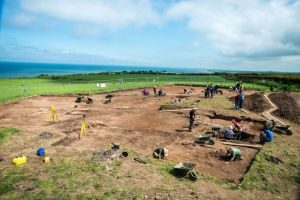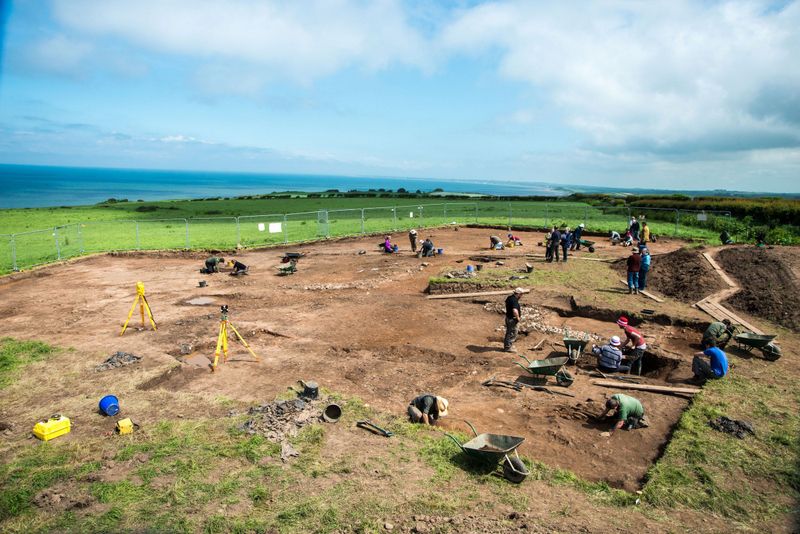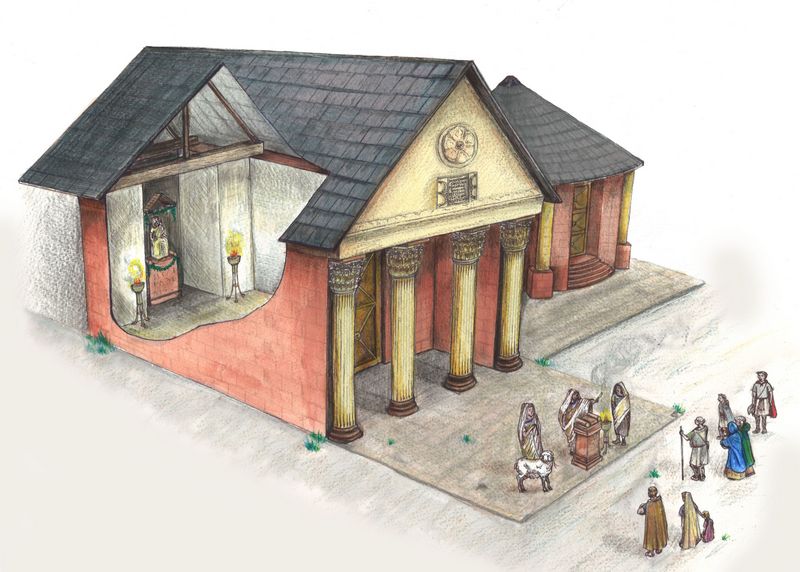
Beginning the fourth year of a five-year program of investigation, a team of archaeologists, students and volunteers commissioned by the Senhouse Museum Trust have returned to a site near the Maryport Roman fort in the U.K. to continue excavation of the remains of a Roman temple and associated structures and features.
Led by Newcastle University’s Professor Ian Haynes and site director Tony Wilmott, they hope to recover more of the structural remains and artifacts at a site that had undergone investigation in previous years, yielding some intriguing results.
“This year we will be looking at the eastern edge of the [Maryport] settlement, to the north east of the fort, where at least one temple stood,” said Haynes. “This structure was originally excavated in the 1880s, and we re-examined it last year.
“Immediately under this building we found the remains of a burnt lamb and bird bones. At other sites across Britain and in other countries these have signified a ritual dedication or offering for the building.
“We also found evidence of a mysterious circular structure next to the rectangular temple and we’re going to be investigating this area to find out what this might have been built for – maybe it was another temple, or a mausoleum.”
Haynes hopes that investigation of this site will help shed additional light on the meaning and importance of stone military altars from the Roman fort of Alauna Carvetiorum and its associated civilian settlement located at what is now Maryport.
“The Temples project is designed to learn more about the internationally famous altars which form the core of the Senhouse Roman Museum display and to understand better the complex religious landscape of Roman Maryport,” said Haynes.
“The collection of altars in the museum is really remarkable. The inscriptions provide information on the lives of the commanders of the fort and their postings across the Roman Empire.
“We want to find out more about exactly where and how they were originally displayed here in Roman times, and how people living in the fort and settlement used rituals such as dedications and offerings.”
Nigel Mills, heritage advisor to the Hadrian’s Wall Trust, said: “The Roman fort and nearby civilian settlement at Maryport were a significant element of the coastal defenses lining the north western boundary of the Roman Empire for more than 300 years.
“Both the Temples project and the Settlement project show there is huge potential to attract more visitors to the Roman Cumbrian coastal defenses which, along with Hadrian’s Wall, are part of the transnational Frontiers of the Roman Empire World Heritage Site.”
____________________________________
Team at work on the Maryport Roman Temples site. Courtesy Senhouse Museum/ Hadrians Wall Trust
____________________________________
Artist’s impression of Maryport Roman Temple. Courtesy Oxford Archaeology Ltd, commissioned by Hadrian’s Wall Trust
_________________________________
The fort built at Maryport was ordered by Hadrian for construction in the second century AD. It served as the command headquarters and supply base for a series of small forts and towers that extended southward along the west coast from Hadrian’s Wall. The Roman fort and civilian settlement at Maryport are part of the Frontiers of the Roman Empire World Heritage Site, which includes Hadrian’s Wall and its attendant forts. The FRE WHS represents the borderline of the Roman Empire at its furthest extent in the 2nd century AD. It stretched from the west coast of northern Britain, through Europe to the Black Sea, and from there to the Red Sea and across North Africa to the Atlantic coast.
More information about the project, how to participate, and the Senhouse Museum generally can be obtained at their website.
_____________________________________________
Additional Information
Tours of the Temples excavation site led by the museum’s volunteer guides start from the museum on weekday afternoons at 2pm and 3.30pm until 18 July. They include entry to the museum and costs are adult £3, child £1, family £8.
Lectures, open days and workshops have also been arranged.
Lectures
- · Thursday 12 June, 7.30pm: The archaeology of drains and cesspits – Don O’Meara. £3
- · Tuesday 1 July, 7.30pm: Interim lecture about the Temples Excavation – Professor Ian Haynes and Tony Wilmott. £3
- · Thursday 17 July, 7.30pm: Final lecture about the Temples Excavation – Professor Ian Haynes and Tony Wilmott. £3
Open days
- · Saturday 21 June, 11am – 5pm: Temples excavation open day. Museum admission applies – adult £3, child £1, family £8
- · Saturday 19 July, 11am – 5pm: Temples excavation open day. Museum admission applies – adult £3, child £1, family £8
Workshops
- · Monday 30 June, 7.30pm: Soils, sediments and landscape – with Don O’Meara. £3 (prebooking essential, limited places)
- · Friday 18 July, 7.30pm: Inorganic material from samples – with Don O’Meara. £3 (prebooking essential, limited places)
The Senhouse Roman Museum is open every day from 10am to 5pm. More information is at www.senhousemuseum.co.uk.
For more information on becoming a volunteer contact Jane Laskey, museum manager.
_________________________________________________
Read about the most fascinating discoveries with a premium subscription to Popular Archaeology Magazine. Find out what Popular Archaeology Magazine is all about. AND MORE:
On the go? Purchase the mobile version of the current issue of Popular Archaeology Magazine here for only $2.99.
Popular Archaeology’s annual Discovery Edition eBook is a selection of the best stories published in Popular Archaeology Magazine in past issues, with an emphasis on some of the most significant, groundbreaking, or fascinating discoveries in the fields of archaeology and paleoanthropology and related fields. At least some of the articles have been updated or revised specifically for the Discovery edition. We can confidently say that there is no other single issue of an archaeology-related magazine, paper print or online, that contains as much major feature article content as this one. The latest issue, volume 2, has just been released. Go to the Discovery edition page for more information.






